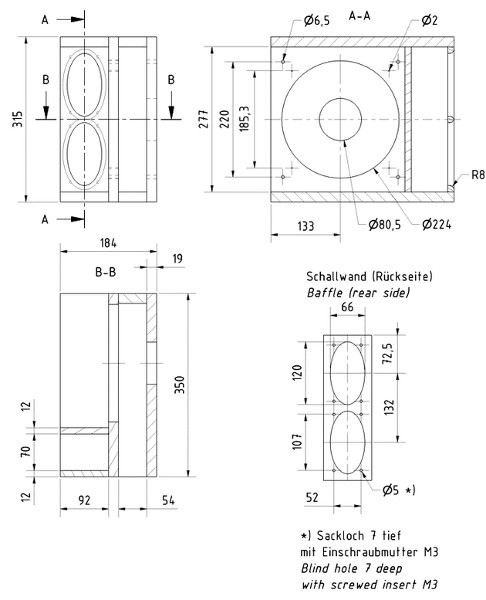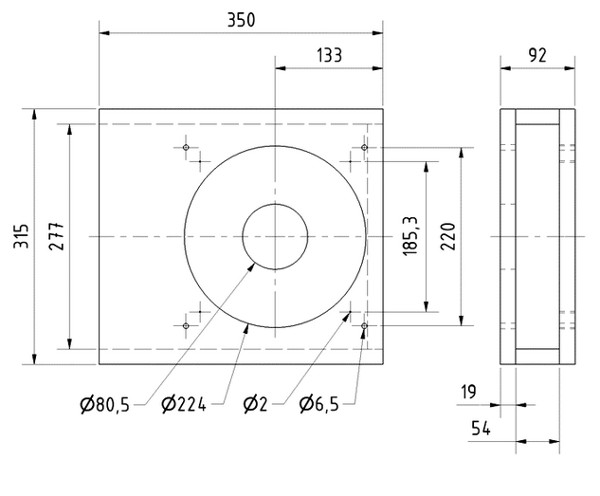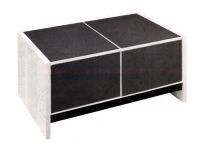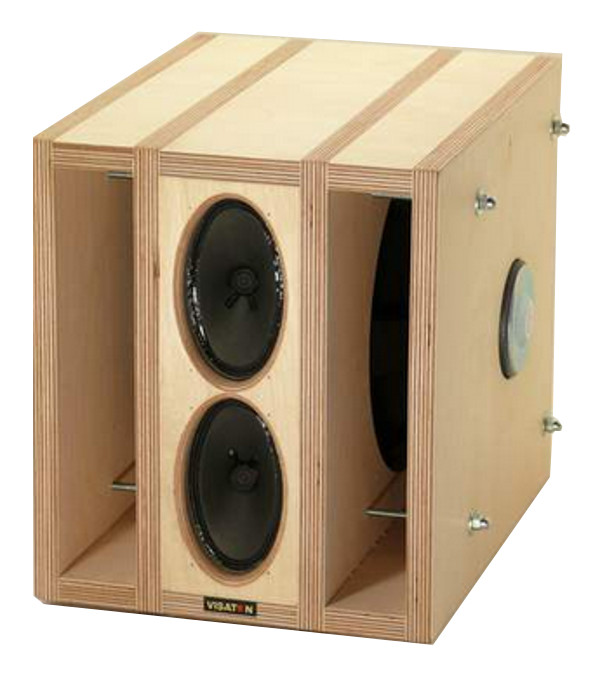Petit Orgue - Speaker KIT without Cabinet
ATTENTION: The price refers to 1 piece, minimum order quantity = 2 pieces!
Characteristics and sound properties
The toughest challenge for a high-end loudspeaker is to reproduce the lowest frequencies of larger instruments, such as an organ or double bass, with appropriate fidelity. Only very few speakers are at all able to reproduce the lowest register of a church organ and even then only the very best are able to make it sound as if it was coming from an organ pipe. To do credit to a double bass in all its glory without sounding fluffy or over-inflated or, even worse, giving up altogether, is the reserve of very few, outstanding loudspeaker constructions. The "Les Orgues" speaker series, in this case the "Petit Orgue" species, represent exactly that capability. With their WS 25 E - 8 Ohm woofers, optimised specifically as a free-air system, mounted in a folded, but open baffle, they are able to reproduce bass down to below 20 Hz in a most natural, unhurried and completely unexaggerated manner and with no sign of weakness. Since there is, in effect, no enclosure, the resonant frequency of the woofer is not increased, which enables it to emanate clear, non-compressed extremely low frequencies.
In contrast to conventional loudspeaker cabinets in which it is the sheer size that determines, to a large extent, their capability to produce very low frequencies, the "Petit Orgue" can indeed compete with its big brother, the "Grand Orgue", in terms of depth. The differences between them are limited, in the main, to the sensitivity and maximum volume level, while the lower limiting frequency is identical. You have to actually hear with your own ears how this unassuming little speaker pumps those deep-black sound waves around the listening room before you can believe it. It may be that the maximum volume level is restricted, but the very fact that it is able to produce lower bass frequencies than most of the larger column speakers is more than impressive.
The precondition for this low-range bass imaging, which uses double-sided radiation, is, however, to ensure the speakers are far enough away from the wall. One metre is sufficient, but for full power right to the bottom of the bass range, 2 - 3 metres is preferable. It is, therefore, not really feasible to use the "Petit Orgue" as a shelf-mounted solution, despite its modest size.
As in the big brother, oval SL 713 - 4 Ohm full-range drivers are responsible for the range above 300 Hz. This moderately priced full-range loudspeaker is characterised by its extremely light paper diaphragm and the voice coil carrier made of kraft paper which, together, ensure absolutely natural sound right through to the highest frequencies. Since only two of them are in use here, there is no need for separate controllers. It is a good idea, however, to use suitable stands to raise the "Petit Orgue" speakers to ear height because the two full-range loudspeakers radiate their output as a beam.
The tonality of these speakers is comparable to that of the "Grand Orgue": highly authentic, direct, dynamic. The bass is incredibly deep and yet retains unobtrusive clarity. With the "Petit Orgue", low-frequency instruments, powerful orchestral moments and voices come across absolutely authentically and with a large portion of live atmosphere. The image of the orchestral layout is clearly defined and focussed, even if, as a result of the construction principle, it cannot quite reproduce the exceptional precision of which the "Grand Orgue" with its 8-fold array is capable.
Be that as it may, the "Petit Orgue" is far more than just a baby brother. It is indeed a fully-fledged high-end loudspeaker system that is designed to appeal to listeners who may not need absolute top-of the range volume levels but who do require deep black crisp bass and extremely authentic instrument layout.
Hint: The bass part of the "Petit Orgue", on its own without the full-range drivers, connected direct up to an active source without a passive crossover, acts as an excellent subwoofer and can be used, either singly or as a pair, to support music-orientated high-end loudspeakers and full-range loudspeakers down to the lowest bass frequencies.
Specifiactions:
ATTENTION: The price refers to 1 piece, minimum order quantity = 2 pieces!
Characteristics and sound properties
The toughest challenge for a high-end loudspeaker is to reproduce the lowest frequencies of larger instruments, such as an organ or double bass, with appropriate fidelity. Only very few speakers are at all able to reproduce the lowest register of a church organ and even then only the very best are able to make it sound as if it was coming from an organ pipe. To do credit to a double bass in all its glory without sounding fluffy or over-inflated or, even worse, giving up altogether, is the reserve of very few, outstanding loudspeaker constructions. The "Les Orgues" speaker series, in this case the "Petit Orgue" species, represent exactly that capability. With their WS 25 E - 8 Ohm woofers, optimised specifically as a free-air system, mounted in a folded, but open baffle, they are able to reproduce bass down to below 20 Hz in a most natural, unhurried and completely unexaggerated manner and with no sign of weakness. Since there is, in effect, no enclosure, the resonant frequency of the woofer is not increased, which enables it to emanate clear, non-compressed extremely low frequencies.
In contrast to conventional loudspeaker cabinets in which it is the sheer size that determines, to a large extent, their capability to produce very low frequencies, the "Petit Orgue" can indeed compete with its big brother, the "Grand Orgue", in terms of depth. The differences between them are limited, in the main, to the sensitivity and maximum volume level, while the lower limiting frequency is identical. You have to actually hear with your own ears how this unassuming little speaker pumps those deep-black sound waves around the listening room before you can believe it. It may be that the maximum volume level is restricted, but the very fact that it is able to produce lower bass frequencies than most of the larger column speakers is more than impressive.
The precondition for this low-range bass imaging, which uses double-sided radiation, is, however, to ensure the speakers are far enough away from the wall. One metre is sufficient, but for full power right to the bottom of the bass range, 2 - 3 metres is preferable. It is, therefore, not really feasible to use the "Petit Orgue" as a shelf-mounted solution, despite its modest size.
As in the big brother, oval SL 713 - 4 Ohm full-range drivers are responsible for the range above 300 Hz. This moderately priced full-range loudspeaker is characterised by its extremely light paper diaphragm and the voice coil carrier made of kraft paper which, together, ensure absolutely natural sound right through to the highest frequencies. Since only two of them are in use here, there is no need for separate controllers. It is a good idea, however, to use suitable stands to raise the "Petit Orgue" speakers to ear height because the two full-range loudspeakers radiate their output as a beam.
The tonality of these speakers is comparable to that of the "Grand Orgue": highly authentic, direct, dynamic. The bass is incredibly deep and yet retains unobtrusive clarity. With the "Petit Orgue", low-frequency instruments, powerful orchestral moments and voices come across absolutely authentically and with a large portion of live atmosphere. The image of the orchestral layout is clearly defined and focussed, even if, as a result of the construction principle, it cannot quite reproduce the exceptional precision of which the "Grand Orgue" with its 8-fold array is capable.
Be that as it may, the "Petit Orgue" is far more than just a baby brother. It is indeed a fully-fledged high-end loudspeaker system that is designed to appeal to listeners who may not need absolute top-of the range volume levels but who do require deep black crisp bass and extremely authentic instrument layout.
Hint: The bass part of the "Petit Orgue", on its own without the full-range drivers, connected direct up to an active source without a passive crossover, acts as an excellent subwoofer and can be used, either singly or as a pair, to support music-orientated high-end loudspeakers and full-range loudspeakers down to the lowest bass frequencies.
Specifiactions:
- Rated power: 70 W
- Maximum power: 150 W
- Nominal impedance Z: 4 Ohm
- Frequency response: 1625000 Hz
- Mean sound pressure level: 76 dB (2,83 V/1 m)
- Cut-off frequency: 300 Hz
- Principle of Housing: Dipole, w-shaped folded open baffle
- Outer dimension height: 315 mm
- Outer dimension width: 276 mm
- Outer dimension depth: 350 mm
Crossover
.jpg)
Frequency & Impedance
.jpg)
Plan
.jpg)
Plan Part 1

Plan Part 2

You have to be logged in and must have bought this product to write a review.
- No review available for this item.
You receive a 2 year warranty from the date of purchase for all of our high quality hifi-products.
If you observe any problem while using the product, you have the possibility to contact our friendly service team.
You can also easily manage your guarantee concern – without being obliged to – under the section My Account.
If you observe any problem while using the product, you have the possibility to contact our friendly service team.
You can also easily manage your guarantee concern – without being obliged to – under the section My Account.
Other Products
-
 -5 %
-5 %

Monacor 2DOT1 - SUB - Speaker KIT without Cabinet
RRP595,00 €
565,25 €




